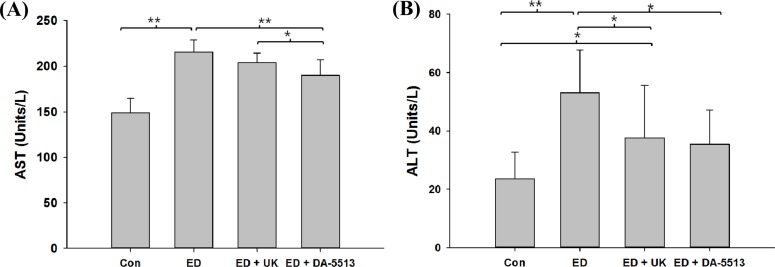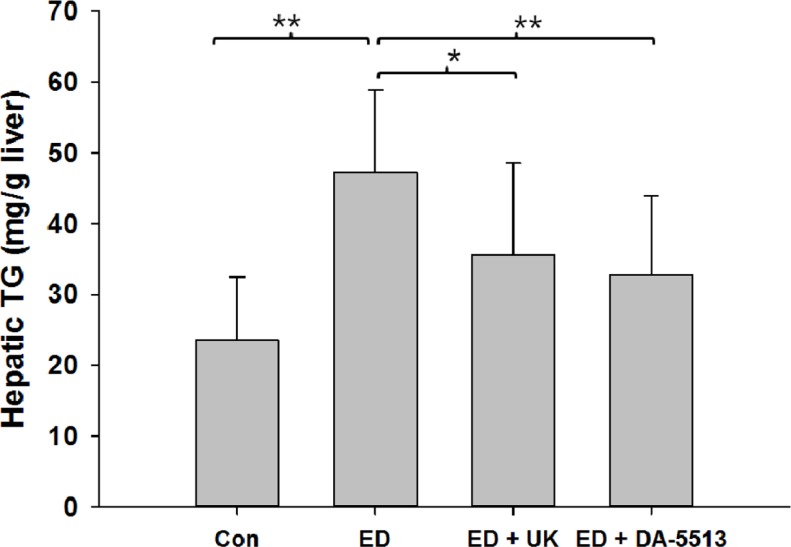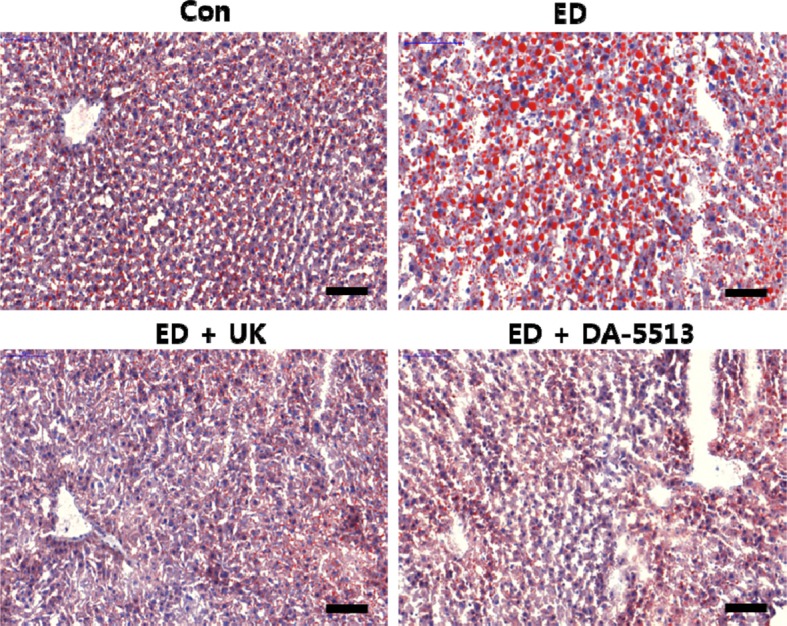This article has been retracted.
See the retraction notice
See the retraction notice
Lab Anim Res.
2018 Jun;34(2):49-57. 10.5625/lar.2018.34.2.49.
Effects of DA-5513 on alcohol metabolism and alcoholic fatty liver in rats
- Affiliations
-
- 1Department of Formulation Development, Dong-A Pharmaceutical Co. Ltd., Yongin, Korea.
- 2College of Pharmacy, Yeungnam University, Gyeongsan, Korea. jongohkim@yu.ac.kr
- 3National Institute of Pharmaceutical Technology, Hanoi University of Pharmacy, Hanoi, Vietnam.
- KMID: 2413843
- DOI: http://doi.org/10.5625/lar.2018.34.2.49
Abstract
- Hangover is characterized by a number of unpleasant physical and mental symptoms that occur after heavy alcohol drinking. In addition, consistently excessive alcohol intake is considered as a major reason causes liver disease. The present study investigated the in vivo effects of DA-5513 (Morning care® Kang Hwang) on biological parameters relevant to hangover relief and alcoholic fatty liver. Blood alcohol and acetaldehyde concentrations were determined in rats administered a single dose of alcohol and treated with DA-5513 or commercially available hangover relief beverages (Yeomyung® and Ukon®). The effects of DA-5513 on alcoholic fatty liver were also determined in rats fed alcohol-containing Lieber-DeCarli diets for 4 weeks. Serum liver function markers (aspartate and alanine aminotransferase activities) and serum/liver lipid levels were assessed. Blood alcohol and acetaldehyde concentrations were lower in the groups treated with DA-5513 or Yeomyung®, as compared with control rats. However, Ukon® did not produce any significant effects on these parameters. Treatment with DA-5513 significantly reduced serum aspartate and alanine aminotransferase activities and markedly reduced serum cholesterol and triglyceride levels, as compared with control rats. Histological observations using Oil Red O staining found that DA-5513 delayed the development of alcoholic fatty liver by reversing hepatic fat accumulation. These findings suggest that DA-5513 could have a beneficial effect on alcohol-induced hangovers and has the potential to ameliorate alcoholic fatty liver.
MeSH Terms
Figure
Reference
-
1. Rehm J, Mathers C, Popova S, Thavorncharoensap M, Teerawattananon Y, Patra J. Global burden of disease and injury and economic cost attributable to alcohol use and alcohol-use disorders. Lancet. 2009; 373(9682):2223–2233. PMID: 19560604.
Article2. Wiese J, McPherson S, Odden MC, Shlipak MG. Effect of Opuntia ficus indica on symptoms of the alcohol hangover. Arch Intern Med. 2004; 164(12):1334–1340. PMID: 15226168.
Article3. Swift R, Davidson D. Alcohol hangover: mechanisms and mediators. Alcohol Health Res World. 1998; 22(1):54–60. PMID: 15706734.4. Lieber CS. Alcoholic fatty liver: its pathogenesis and mechanism of progression to inflammation and fibrosis. Alcohol. 2004; 34(1):9–19. PMID: 15670660.
Article5. Altamirano J, Bataller R. Alcoholic liver disease: pathogenesis and new targets for therapy. Nat Rev Gastroenterol Hepatol. 2011; 8(9):491–501. PMID: 21826088.
Article6. Purohit V, Gao B, Song BJ. Molecular mechanisms of alcoholic fatty liver. Alcohol Clin Exp Res. 2009; 33(2):191–205. PMID: 19032584.
Article7. Lafontan M, Girard J. Impact of visceral adipose tissue on liver metabolism: Part I: Heterogeneity of adipose tissue and functional properties of visceral adipose tissue. Diabetes Metab. 2008; 34(4 Pt 1):317–327. PMID: 18550411.8. Wree A, Kahraman A, Gerken G, Canbay A. Obesity affects the liver-the link between adipocytes and hepatocytes. Digestion. 2011; 83(1-2):124–133. PMID: 21042023.9. Zhong W, Zhao Y, Tang Y, Wei X, Shi X, Sun W, Sun X, Yin X, Sun X, Kim S, McClain CJ, Zhang X, Zhou Z. Chronic alcohol exposure stimulates adipose tissue lipolysis in mice: role of reverse triglyceride transport in the pathogenesis of alcoholic steatosis. Am J Pathol. 2012; 180(3):998–1007. PMID: 22234172.10. Addolorato G, Capristo E, Greco AV, Stefanini GF, Gasbarrini G. Influence of chronic alcohol abuse on body weight and energy metabolism: is excess ethanol consumption a risk factor for obesity or malnutrition? J Intern Med. 1998; 244(5):387–395. PMID: 9845854.
Article11. Li Y, Wong K, Giles A, Jiang J, Lee JW, Adams AC, Kharitonenkov A, Yang Q, Gao B, Guarente L, Zang M. Hepatic SIRT1 attenuates hepatic steatosis and controls energy balance in mice by inducing fibroblast growth factor 21. Gastroenterology. 2014; 146(2):539–549.e7. PMID: 24184811.
Article12. Suter PM, Schutz Y, Jequier E. The effect of ethanol on fat storage in healthy subjects. N Engl J Med. 1992; 326(15):983–987. PMID: 1545851.
Article13. Neuschwander-Tetri BA. Hepatic lipotoxicity and the pathogenesis of nonalcoholic steatohepatitis: the central role of nontriglyceride fatty acid metabolites. Hepatology. 2010; 52(2):774–788. PMID: 20683968.
Article14. Pulido-Moran M, Moreno-Fernandez J, Ramirez-Tortosa C, Ramirez-Tortosa M. Curcumin and health. Molecules. 2016; 21(3):264. PMID: 26927041.
Article15. You Y, Duan X, Wei X, Su X, Zhao M, Sun J, Ruenroengklin N, Jiang Y. Identification of major phenolic compounds of Chinese water chestnut and their antioxidant activity. Molecules. 2007; 12(4):842–852. PMID: 17851436.16. Vargas-Mendoza N, Madrigal-Santillán E, Morales-González Á, Esquivel-Soto J, Esquivel-Chirino C, García-Luna y González-Rubio M, Gayosso-de-Lucio JA, Morales-González JA. Hepatoprotective effect of silymarin. World J Hepatol. 2014; 6(3):144–149. PMID: 24672644.17. Chang BY, Lee DS, Lee JK, Kim YC, Cho HK, Kim SY. Protective activity of kudzu (Pueraria thunbergiana) vine on chemically-induced hepatotoxicity: in vitro and in vivo studies. BMC Complement Altern Med. 2016; 16:39. PMID: 26825303.
Article18. Mattei R, Dias RF, Espínola EB, Carlini EA, Barros SB. Guarana (Paullinia cupana): toxic behavioral effects in laboratory animals and antioxidants activity in vitro. J Ethnopharmacol. 1998; 60(2):111–116. PMID: 9582000.19. Cheng N, Du B, Wang Y, Gao H, Cao W, Zheng J, Feng F. Antioxidant properties of jujube honey and its protective effects against chronic alcohol-induced liver damage in mice. Food Funct. 2014; 5(5):900–908. PMID: 24603671.
Article20. Kober H, Tatsch E, Torbitz VD, Cargnin LP, Sangoi MB, Bochi GV, da Silva AR, Barbisan F, Ribeiro EE, da Cruz IB, Moresco RN. Genoprotective and hepatoprotective effects of Guarana (Paullinia cupana Mart. var. sorbilis) on CCl4-induced liver damage in rats. Drug Chem Toxicol. 2016; 39(1):48–52. PMID: 25791997.21. Kim CI, Leo MA, Lowe N, Lieber CS. Differential effects of retinoids and chronic ethanol consumption on membranes in rats. J Nutr. 1988; 118(9):1097–1103. PMID: 3418417.
Article22. Yin HQ, Lee BH. Temporal changes in the hepatic fatty liver in mice receiving standard Lieber-DeCarli diet. Toxicol Res. 2008; 24(2):113–117.
Article23. Bligh EG, Dyer WJ. A rapid method of total lipid extraction and purification. Can J Biochem Physiol. 1959; 37(8):911–917. PMID: 13671378.
Article24. Levene AP, Kudo H, Thursz MR, Anstee QM, Goldin RD. Is oil red-O staining and digital image analysis the gold standard for quantifying steatosis in the liver? Hepatology. 2010; 51(5):1859. PMID: 20432267.
Article25. Kucherenko MM, Marrone AK, Rishko VM, Yatsenko AS, Klepzig A, Shcherbata HR. Paraffin-embedded and frozen sections of drosophila adult muscles. J Vis Exp. 2010; (46):2438. PMID: 21206479.26. Fakhoury-Sayegh N, Trak-Smayra V, Khazzaka A, Esseily F, Obeid O, Lahoud-Zouein M, Younes H. Characteristics of nonalcoholic fatty liver disease induced in wistar rats following four different diets. Nutr Res Pract. 2015; 9(4):350–357. PMID: 26244072.
Article27. Yogalakshmi B, Sreeja S, Geetha R, Radika MK, Anuradha CV. Grape Seed Proanthocyanidin Rescues Rats from Steatosis: A Comparative and Combination Study with Metformin. J Lipids. 2013; 2013:153897. PMID: 24307947.
Article28. Lieber CS. Alcohol: its metabolism and interaction with nutrients. Annu Rev Nutr. 2000; 20(1):395–430. PMID: 10940340.
Article29. Lu Y, Cederbaum AI. CYP2E1 and oxidative liver injury by alcohol. Free Radic Biol Med. 2008; 44(5):723–738. PMID: 18078827.
Article30. Guengerich FP, Beaune PH, Umbenhauer DR, Churchill PF, Bork RW, Dannan GA, Knodell RG, Lloyd RS, Martin MV. Cytochrome P-450 enzymes involved in genetic polymorphism of drug oxidation in humans. Biochem Soc Trans. 1987; 15(4):576–578. PMID: 3678578.
Article31. Stewart S, Jones D, Day CP. Alcoholic liver disease: new insights into mechanisms and preventative strategies. Trends Mol Med. 2001; 7(9):408–413. PMID: 11530336.
Article32. Ceni E, Mello T, Galli A. Pathogenesis of alcoholic liver disease: role of oxidative metabolism. World J Gastroenterol. 2014; 20(47):17756–17772. PMID: 25548474.
Article33. Lakshman MR. Some novel insights into the pathogenesis of alcoholic steatosis. Alcohol. 2004; 34(1):45–48. PMID: 15670665.
Article34. Lieber CS, DeCarli LM, Sorrell MF. Experimental methods of ethanol administration. Hepatology. 1989; 10(4):501–510. PMID: 2673971.
Article35. Adams LA, Lymp JF, St Sauver J, Sanderson SO, Lindor KD, Feldstein A, Angulo P. The natural history of nonalcoholic fatty liver disease: a population-based cohort study. Gastroenterology. 2005; 129(1):113–121. PMID: 16012941.
Article36. Hong M, Li S, Tan HY, Wang N, Tsao SW, Feng Y. Current status of herbal medicines in chronic liver disease therapy: the biological effects, molecular targets and future prospects. Int J Mol Sci. 2015; 16(12):28705–28745. PMID: 26633388.
Article37. Lee HS, Song J, Kim TM, Joo SS, Park D, Jeon JH, Shin S, Park HK, Lee WK, Ly SY, Kim MR, Lee DI, Kim YB. Effects of a preparation of combined glutathione-enriched yeast and rice embryo/soybean extracts on ethanol hangover. J Med Food. 2009; 12(6):1359–1367. PMID: 20041794.
Article38. Takahashi H, Greenway H, Matsumura H, Tsutsumi N, Nakazono M. Rice alcohol dehydrogenase 1 promotes survival and has a major impact on carbohydrate metabolism in the embryo and endosperm when seeds are germinated in partially oxygenated water. Ann Bot. 2014; 113(5):851–859. PMID: 24431339.
Article39. Kiso Y, Suzuki Y, Watanabe N, Oshima Y, Hikino H. Antihepatotoxic principles of Curcuma longa rhizomes. Planta Med. 1983; 49(3):185–187. PMID: 6657788.
Article40. Reddy AC, Lokesh BR. Effect of dietary turmeric (Curcuma longa) on iron-induced lipid peroxidation in the rat liver. Food Chem Toxicol. 1994; 32(3):279–283. PMID: 8157223.41. Sasaki H, Sunagawa Y, Takahashi K, Imaizumi A, Fukuda H, Hashimoto T, Wada H, Katanasaka Y, Kakeya H, Fujita M, Hasegawa K, Morimoto T. Innovative preparation of curcumin for improved oral bioavailability. Biol Pharm Bull. 2011; 34(5):660–665. PMID: 21532153.
Article42. Hamano T, Nishi M, Itoh T, Ebihara S, Watanabe Y. The effect of beverage containing curcuma longa L. extract on the alcohol metabolism of healthy volunteers. Oyo Yakuri (Pharmacometrics). 2007; 72(1-2):31–38.43. Kamal-Eldin A, Frank J, Razdan A, Tengblad S, Basu S, Vessby B. Effects of dietary phenolic compounds on tocopherol, cholesterol, and fatty acids in rats. Lipids. 2000; 35(4):427–435. PMID: 10858028.
Article44. Fehér J, Deák G, Müzes G, Láng I, Niederland V, Nékám K, Kárteszi M. Liver-protective action of silymarin therapy in chronic alcoholic liver diseases. Orv Hetil. 1989; 130(51):2723–2727. PMID: 2574842.45. Ferenci P, Dragosics B, Dittrich H, Frank H, Benda L, Lochs H, Meryn S, Base W, Schneider B. Randomized controlled trial of silymarin treatment in patients with cirrhosis of the liver. J Hepatol. 1989; 9(1):105–113. PMID: 2671116.
Article46. Kim YS, Hwang JW, Jang JH, Son S, Seo IB, Jeong JH, Kim EH, Moon SH, Jeon BT, Park PJ. Trapa japonica pericarp extract reduces LPS-induced inflammation in macrophages and acute lung injury in mice. Molecules. 2016; 21(3):392. PMID: 27007369.
Article47. Kim YS, Hwang JW, Han YK, Kwon HJ, Hong H, Kim EH, Moon SH, Jeon BT, Park PJ. Antioxidant activity and protective effects of Trapa japonica pericarp extracts against tert-butylhydroperoxide-induced oxidative damage in Chang cells. Food Chem Toxicol. 2014; 64:49–56. PMID: 24269339.
Article48. Kim YS, Kim EK, Hwang JW, Seo IB, Jang JH, Son S, Jeong JH, Moon SH, Jeon BT, Park PJ. Characterization of the antioxidant fraction of Trapa japonica pericarp and its hepatic protective effects in vitro and in vivo. Food Funct. 2016; 7(3):1689–1699. PMID: 26956465.
Article49. Chen G, Li L. Nutrient consumption and production of isoflavones in bioreactor cultures of Pueraria Iobata (Willd). J Environ Biol. 2007; 28(2):321–326. PMID: 17915773.50. Yamazaki T, Hosono T, Matsushita Y, Kawashima K, Someya M, Nakajima Y, Narui K, Hibi Y, Ishizaki M, Kinjo J, Nohara T. Pharmacological studies on Puerariae Flos. IV: Effects of Pueraria thomsonii dried flower extracts on blood ethanol and acetaldehyde levels in humans. Int J Clin Pharmacol Res. 2002; 22(1):23–28. PMID: 12395916.
- Full Text Links
- Actions
-
Cited
- CITED
-
- Close
- Share
- Similar articles
-
- Retraction Note: Effects of DA-5513 on alcohol metabolism and alcoholic fatty liver in rats
- The effects of moderate alcohol consumption on non-alcoholic fatty liver disease
- Should you advocate for hepatocellular carcinomasurveillance in patients with alcohol-related liverdisease or non-alcoholic fatty liver disease?
- KASL Clinical Practice Guidelines: Management of Alcoholic Liver Disease
- Are patients with alcohol-related fatty liver at increased risk of coronary heart disease?





